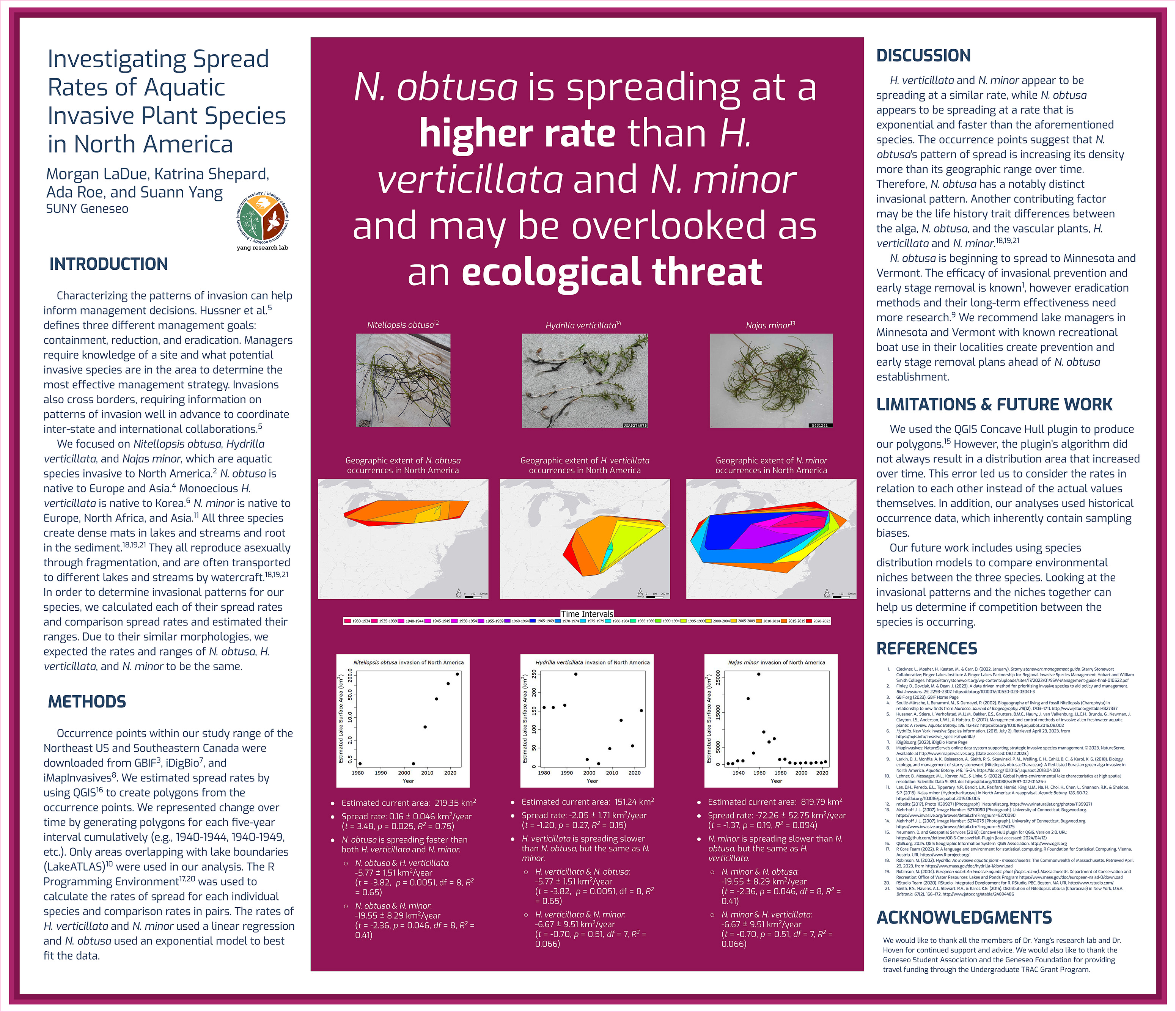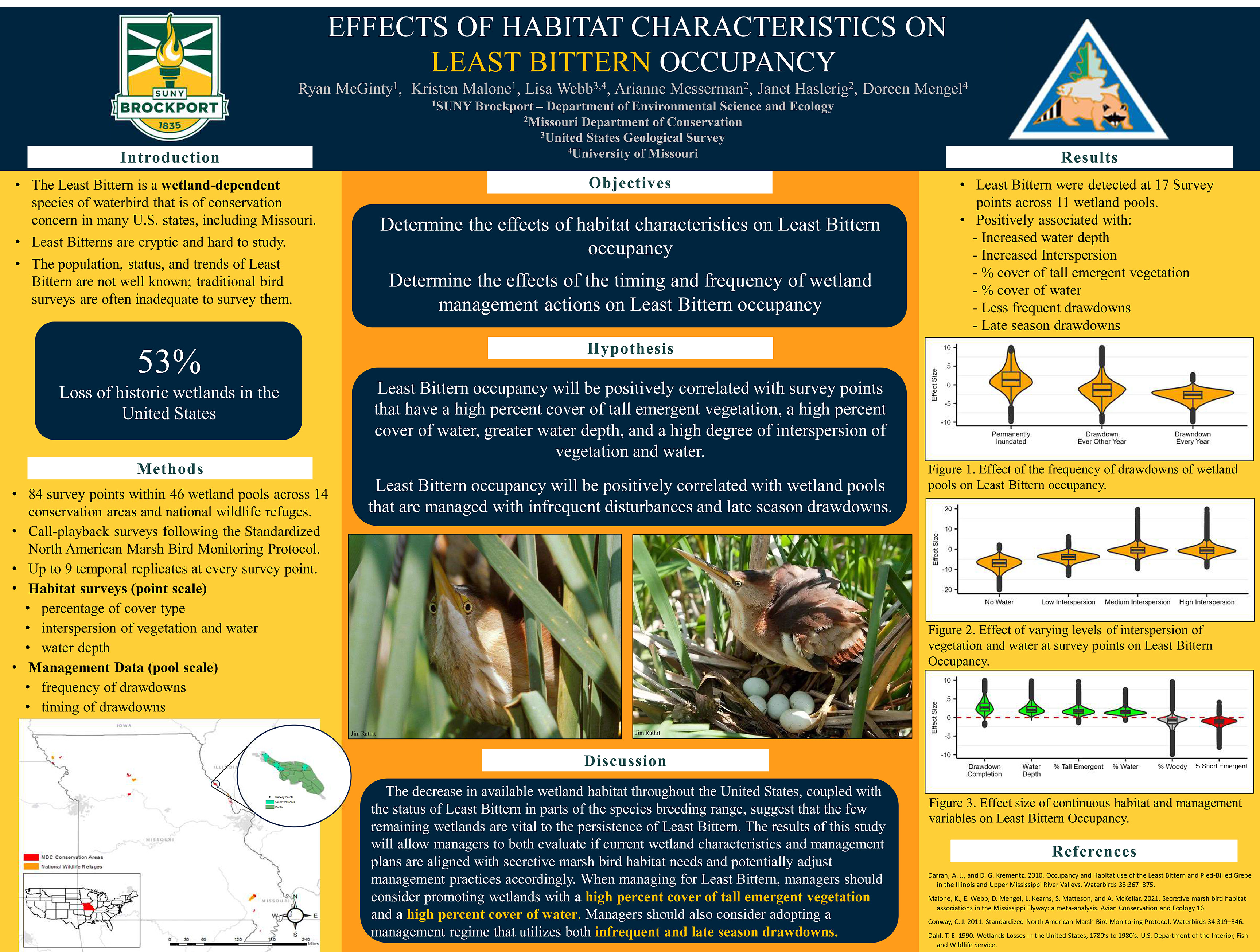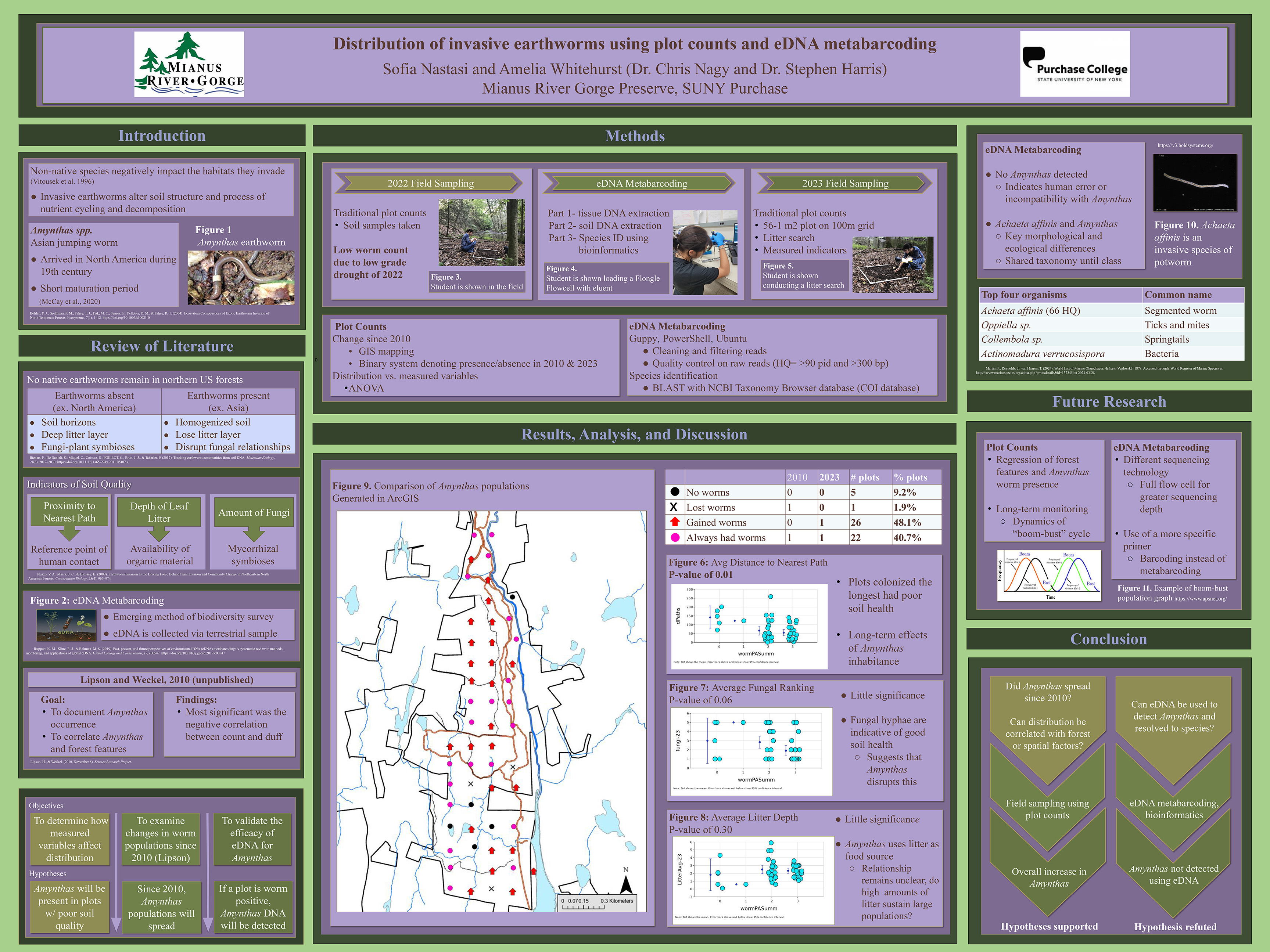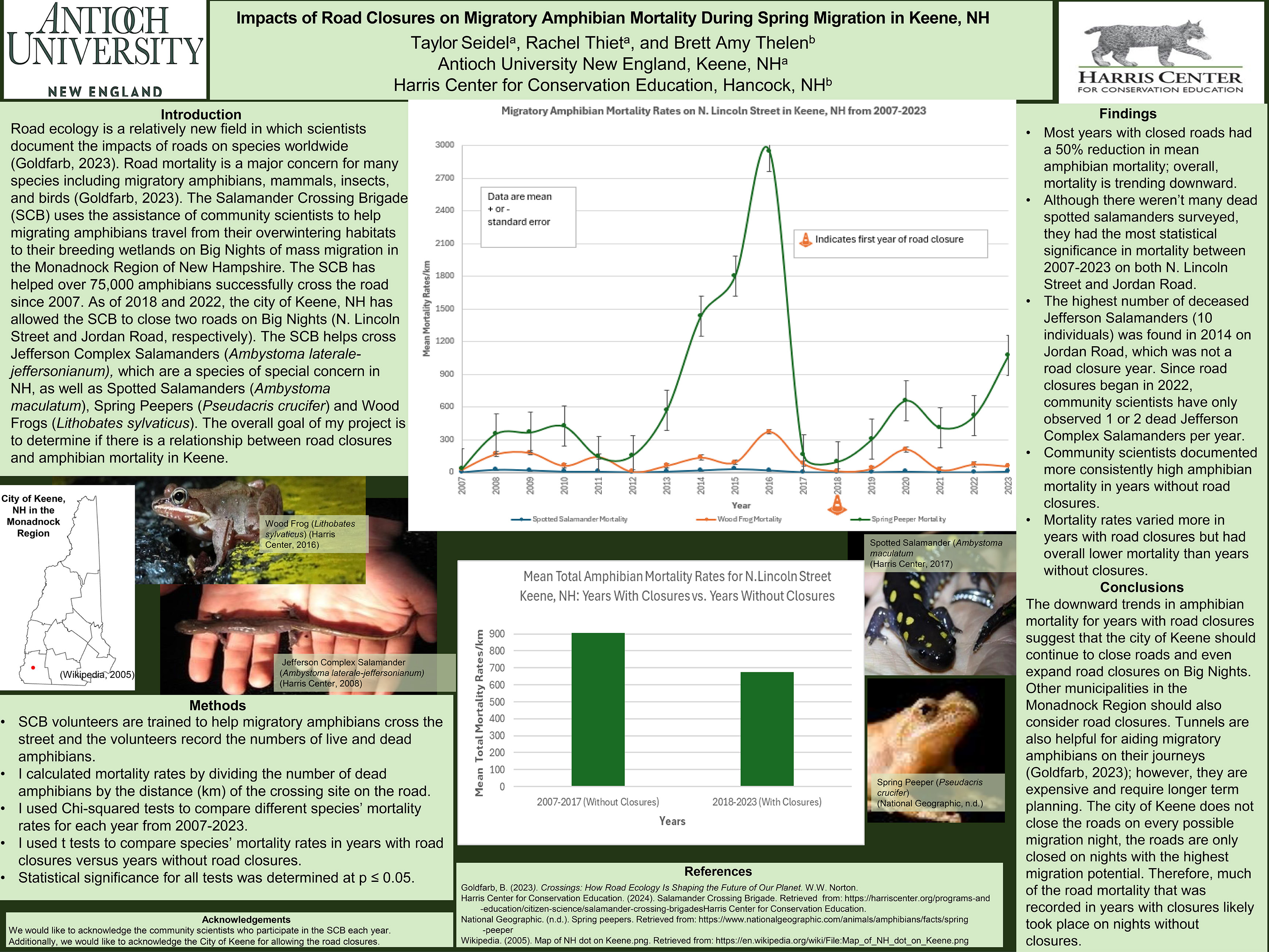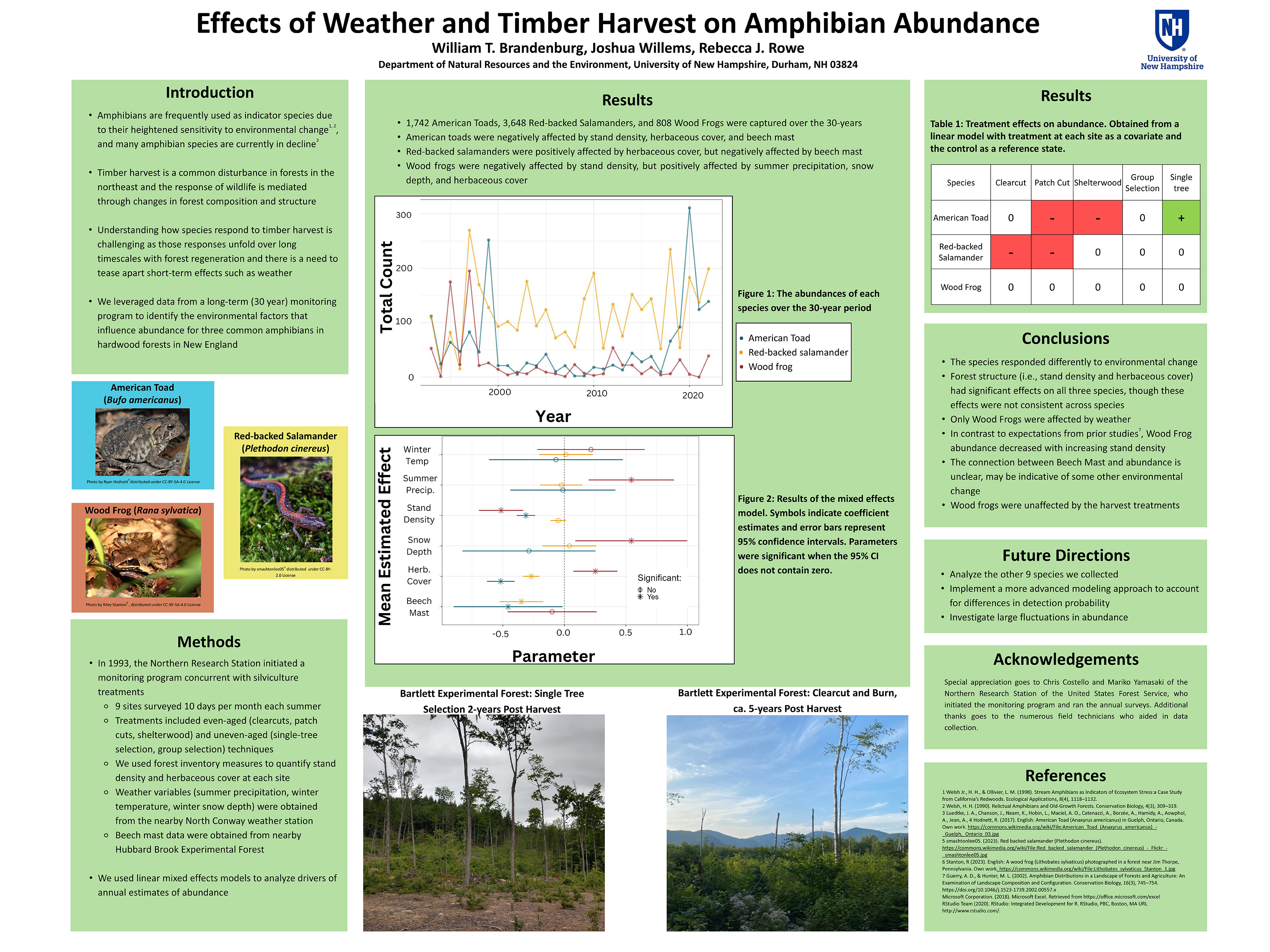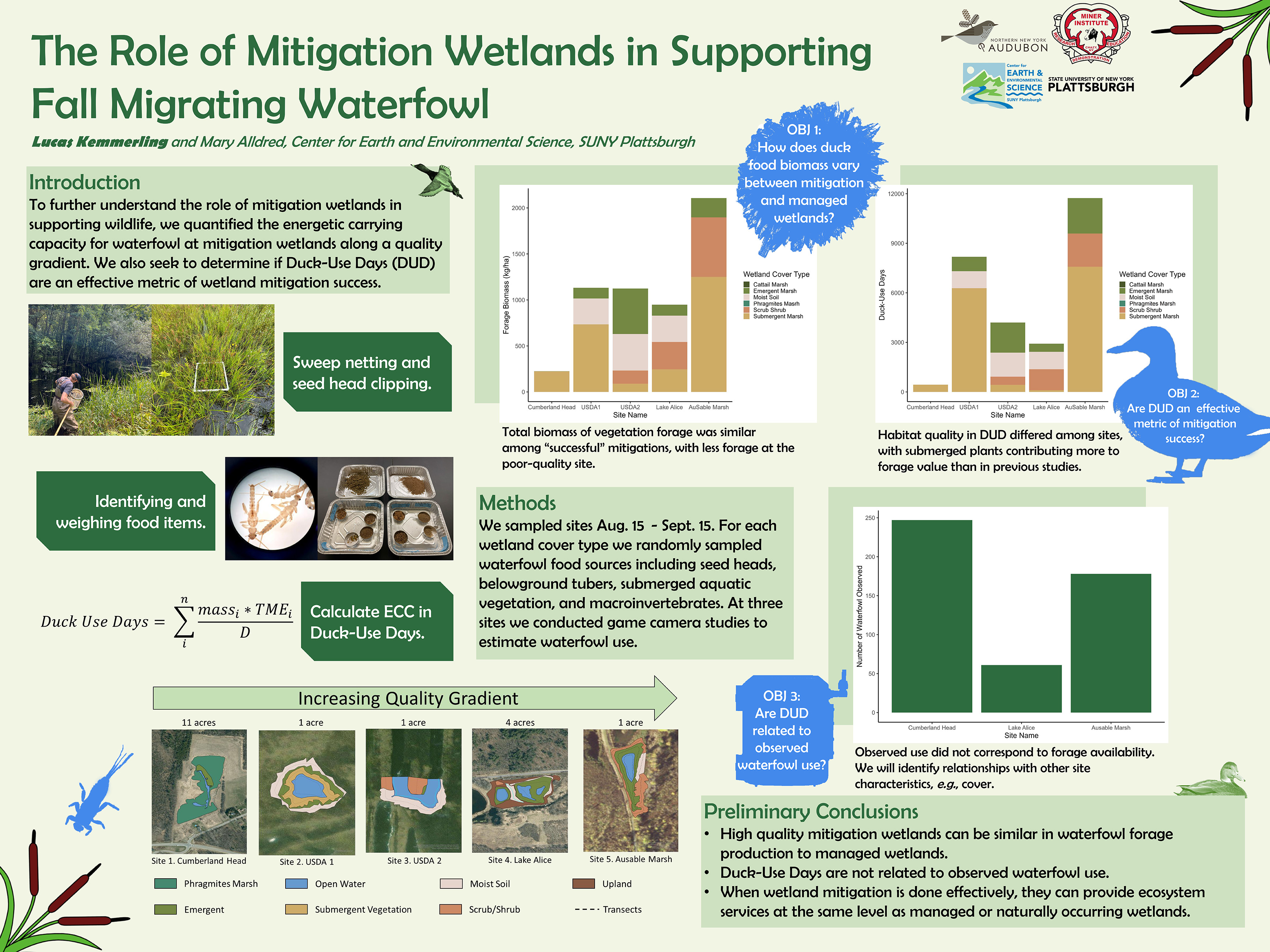☺☺☺ Student Poster Presentation Winners ☺☺☺
First Place
| Undergrad/High School | Grad Student |
Katrina Shepard and Morgan LaDue Co-authors: Ada Roe and Suann Yang Investigating Spread Rates of Aquatic Invasive Plant Species in North America Abstract - Aquatic invasive species have detrimental effects on the ecosystems of the northeastern United States and eastern Canada. Aquatic plants can create dense mats in lakes which pose concerns for lake managers, like blocking sunlight for native species and impeding boat travel. Watercraft are well-known for transporting aquatic plants that reproduce asexually and spread through fragmentation to other lakes and streams. Characterizing the patterns of invasion for aquatic invasive species can be important for making local management decisions to control them. We focused on Najas minor (Brittle Waternymph), Hydrilla verticillata (Hydrilla), and Nitellopsis obtusa (Starry Stonewort), which disperse through fragments transported by boats and form dense mats. To characterize their patterns of invasion, we estimated our species’ ranges and rates of spread, then compared these rates. We first compiled occurrence records of N. minor, H. verticillata, and N. obtusa from the online databases GBIF, iDigBio, and iMapInvasives. We then used QGIS to estimate the range, at different intervals of time, for each species since their arrival in North America. These ranges include lake surface area only. Finally, we calculated the spread rates and performed a linear regression analysis to compare them using the R Programming Environment. Our preliminary results showed that all 3 species have spread at the same rate. In addition, the range of H. verticillata is ~71.8 km2, while the ranges of N. minor and N. obtusa are roughly 20x and 60x that of H. verticillata, respectively. Hydrilla verticillata has been identified as a local problem by several municipalities and has had extensive removal efforts, potentially contributing to its smaller range, despite having the same spread rate as the other species. Rates of spread and ranges can inform patterns of invasion, which can be used to predict locations at risk of invasion and allow lake managers to implement prevention policies. Spread rates at areas of co-occurrence could be useful in future studies of invasional meltdown.
|
Ryan McGinty Co-authors: Kristen Malone, Lisa Webb, Arianne Messerman, Janet Haslerig, and Doreen Mengel Effect of Habitat Characteristics and Wetland Management on Least Bittern Occupancy in Missouri Abstract - Ixobrychus exilis (Least Bittern) is a species of secretive marsh bird that depends on wetland habitat throughout its life cycle. It is a species of conservation concern in several US states where their populations are declining, likely due to habitat loss. The purpose of this project is to determine the effect of habitat characteristics and wetland management practices on Least Bittern distribution in a portion of their breeding range. To accomplish this, we conducted call-playback surveys at 84 survey points placed in 43 emergent wetland pools. We collected both habitat data at every survey point and data on the management practices at each wetland pool. Least Bittern site occupancy was positively associated with percent cover of both tall emergent vegetation (β = 0.741, 95% CI = 0.107, 1.569) and open water (β = 0.957, CI = 0.320, 1.716) and negatively associated with percent cover of both short emergent vegetation (β = -0.723, CI = -1.569, -0.009) and bare ground (β = -1.225, CI = -2.48,-0.264). Water depth was positively associated with Least Bittern occupancy (β = 1.429, CI = 0.614, 2.521). Points with greater interspersion were more likely to be occupied by Least Bittern (mean occupancy = 0.499, CI = 0.256, 0.786) than points with less interspersion (mean occupancy = 0.175, CI = 0.051, 0.367). Wetland pools that were permanently inundated with water were more likely to be occupied by Least Bittern (mean occupancy = 0.700, 95% CI = 0.330, 0.976) than sites that were drawn down every other year (mean occupancy = 0.488, CI 0.137, 0.883) or every year (mean occupancy = 0.207, CI = 0.077, 0.380). Least Bittern occupancy was also positively associated with a later initiation of spring drawdowns (effect size = 1.384, CI = 0.288, 4.490). The decrease in wetland habitat in the US coupled with the decline in Least Bittern populations in portions of their breeding range suggest that the few remaining wetlands are crucial for the persistence of Least Bittern. The results of this project may help inform what habitat characteristics can be managed in a manner to benefit Least Bittern populations.
|
Second Place
| Undergrad/High School | Grad Student |
Sofia Nastasi Co-authors: Chris Nagy, Amelia Whitehurst, and Stephen Harris Distribution of Invasive Earthworms in a Suburban Nature Preserve in Southern NY Determined Using Fieldwork and eDNA Metabarcoding Abstract - Non-native species negatively impact the habitats they invade. Amynthas spp., a genus of South Asian earthworm, is becoming increasingly common in coastal North American habitats. Earthworms are epigeic detritivores, they live in and use the litter layer found above soil as a food source. Their role is essential to a functioning ecosystem but becomes detrimental in excess. Lack of natural predators in North American ecosystems and an annual life cycle allow these earthworms to over-consume available organic matter, resulting in wasted nutrients and unwanted competition. It is understood how they cause ecological distress, but not the patterns that influence distribution. We sampled 56 plots for Amynthas at the Mianus River Gorge Preserve in Bedford, NY. We analyzed worm distribution with indicators of soil health and forest features and compared our data to a previous survey performed in 2010. We found that Amynthas distribution increased throughout the preserve. In addition, we used eDNA metabarcoding analysis with the goal of detecting Amynthas DNA as an alternative sampling method. Soil samples underwent DNA extraction, PCR, and sequencing for species identification. Amynthas spp. were not detected; however, we did detect another segmented worm species, Achaeta affinis. Achaeta affins is a European potworm species with key morphological and ecological similarities to Amynthas.
|
Taylor Seidel Co-author: Rachel Thiet and Brett Amy Thelen Impacts of Road Closures on Migratory Amphibian Mortality During Spring Migration in Keene, New Hampshire Abstract - Amphibians are an important part of biological diversity and are considered an indicator species in many ecosystems. Unfortunately, amphibians are some of the fastest disappearing species in the world due to several factors, including human development; habitat fragmentation is particularly problematic for migratory amphibians because they need to travel from their overwintering locations to wetlands to breed. Many of the migration routes these species have relied on for generations have been fragmented by road construction, which puts migratory amphibians at an increased risk of mortality due to motor vehicles. On rainy spring nights in New England (“big nights”), amphibians emerge and travel to their breeding habitats. Various programs around the world assist amphibians with this journey; one such program is the Salamander Crossing Brigade (SCB) managed by the Harris Center for Conservation Education in Hancock, NH. In the 17 years the project has been active in southwestern New Hampshire, SCB volunteers have steered >75,000 amphibians, including Ambystoma maculatum (Spotted Salamander), Ambystoma laterale-jeffersonianum (Jefferson complex salamanders; a species of special concern in NH), Lithobates sylvaticus (Wood Frog), and Pseudacris crucifer (Spring Peeper), away from the dangers of motor vehicles and safely to their breeding pools. More recently, the Harris Center has worked with the City of Keene, NH, to close 2 highly trafficked (by both cars and amphibians) roads on “big nights” to reduce amphibian mortality. The overall goal of my project is to determine if there is a relationship between road closures and amphibian mortality in Keene. Preliminary data suggest closing roads has reduced amphibian mortality by over 50% on “big nights”. I will share the results of full data analyses in this poster. Our results will be of interest to the City of Keene, NH, the Harris Center for Conservation Education, herpetologists, conservation biologists, and road ecologists.
|
Third Place
| Undergrad/High School | Grad Student |
William Brandenburg Co-author: Joshua Willems and Rebecca J. Rowe Effects of Timber Harvesting Techniques on Amphibian Populations Abstract -Timber harvests function as disturbances that may affect habitat suitability for species in forest ecosystems. We investigated the effects of different timber-harvesting techniques on 3 amphibian species: Bufo americanus (American Toad), Plethodon cinereus (Red-backed Salamander), and Rana sylvatica (Wood Frog). Every summer since 1994, pitfall traps were placed at 9 sites in the Bartlett Experimental Forest in the White Mountains of New Hampshire; each site was subjected to a different method of timber harvest (clearcut, single-tree selection, shelterwood, group cut, and patch cut; 1 of the sites also experienced an ice storm) with 1 of the sites serving as an unharvested control site. We then compared the counts of the target species at each site against different aspects of forest structure and weather. One of these factors, mean herbaceous cover, had a negative effect on the American Toad counts, but a positive effect on the Red-backed Salamander and Wood Frog counts, according to our preliminary results. As amphibians are particularly sensitive to environmental change, these data could reveal how timber harvests affect forest ecosystems as a whole and should be used to inform silvicultural practices.
|
Lucas Kemmerling Co-authors: Mary Alldred The Role of Small Mitigation Wetlands in Supporting Fall Migrating Waterfowl Abstract - Due to high rates of wetland loss in the United States, legislators under the Clean Water Act have adopted a “no net loss” policy of wetland conservation requiring that if wetlands are to be disturbed, then mitigation efforts are required to offset disturbance. An EPA study revealed these restored, created, or enhanced mitigation wetlands are on average just 1.7 ha (4.3 ac) and can be found anywhere from urban centers to rural areas like the Champlain Valley. This mosaic of small wetlands across the landscape offers important stopover habitat for migratory birds like waterfowl. Unfortunately, not all mitigation wetlands are created equally, and their role in supporting migratory waterfowl is not well studied. Research has revealed that just 21% of mitigation wetlands meet the standards of ecological equivalency to that of the originally disturbed wetland. When this loss of quality is extrapolated across the landscape, we risk the degradation of habitat for species we find valuable, like waterfowl. The aim of our research is to better understand the role of small mitigation wetlands in supporting fall migrating waterfowl to inform quality standards of wetland mitigation. Our research does this by determining the energetic carrying capacity of 5 restored, created, or enhanced wetlands for waterfowl in the Lake Champlain Valley. We used stratified random sampling of plant and invertebrate food biomass (kg/ha) for waterfowl in late summer of 2023 before the fall migration. We divided wetlands into habitat types where we collected potenatial waterfowl food items such as emergent vegetation, invertebrates, tubers, and submerged aquatic vegetation. We dried and weighed the waterfowl food items and will use these data to estimate the number of waterfowl each wetland can support. Additionally, we have conducted camera surveys to estimate actual waterfowl use at each study area to be compared to estimated carrying capacity. We are currently processing samples and beginning to analyze data with preliminary results to be presented at NENHC.
|
About the Conference


